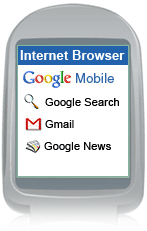Access Services and Datas through On Device Portals, content and service war ahead….
Thomas Menguy | March 20, 2007On Device Portals, or the new magic Eldorado? If you are not familiar with the term (I think it is an ArcChart one, but not sure) , an On device Portal is a way to access quickly and easily your services and data on your phone: to provide a good user experience to the user when consumming services and contents.
This is a generic term that can be applied (at least according to me ![]() ) in more or less extent to many industry actors:
) in more or less extent to many industry actors:
- Home Screen providers (like Abaxia, the guys behind the Orange Home screen or others)
- Widgets Framework Providers (Opera goes here, or mobease…)
- some actors like Macromedia Flash Cast
- …and, looking at recent developments, service provider seeking desperatly to find their way on mobile phones: Google, Microsoft and Yahoo.
To promote their services they are in fact trying to replace as much as possible the traditional ways services are, poorly, presented to the end user today by mass market phones.
They are already fighting each other (see this yahoo mobile vs google mobile comparison at Yahoo) , this comparison between Google Maps and MS Maps (mobile) : There is something big here, and Carrier have long understood that the Home Screen is a key part to drive th euser behaviours and services use, because everything is one click away. Bringing big added value services to a one click access in a phone seems to be the new holly grail (see this example for GPS at TomSoft but it is one of many many)….
And again who are on their ways? : Carriers that are trying to do the same thing, alongside big brand OEM (above all Nokia and SE).
It’s perhaps why Google is working on its own phone, and how amazed I was when I read this:
A job posting on Google web site is being taken by many as proof that Google is developing some kind of wireless device that can use its web services.
The job posting in question says:
Google organizes information and makes it accessible and useful. To improve accessibility, Google is experimenting with a few wireless communications systems including some completely novel concepts. We are building a small team of top-notch Logic Designers and Analog Designers aimed at nothing less than making the entire world’s information accessible from anywhere for free. Are you in?
The posting goes on to say that a qualified applicant needs to have an Electrical Engineering or related technical degree, extensive circuit modeling and analysis experience, and excellent programming skills.
Job Posting Sets Off New Round of Google Phone Rumors
(see also here :
Simeon Simeonov is in the news for his story on the Google phone! Simeon Simeonov is in the news for his story on the Google phone!
Simeon Simeonov is in the news for his story on the Google phone! )
They are hiring HARDWARE engineers! wow this is a blast as it is for sure not their core business nor competency, and they prefer to do that instead of speaking with the today chipset vendors (Texas Instrument, NXP (ex Philips Semi), Infineon, ADI, Broadcomm…). I really don’t know where they are going or what is this strange strategy: but they made the point clear: they want to control the whole experience…exciting!
What do you think?





















